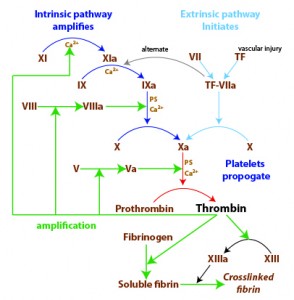Initiation of thrombin generation: Subendothelial tissue factor (TF) on fibroblasts (and smooth muscle cells) is exposed by vascular injury and binds its ligand, plasma FVII. Once bound to TF, FVII autoactivates and the TF-FVII complex forms the “extrinsic tenase”, which activates FX on fibroblasts (not shown). Factor Xa alone can activate small amounts of its cofactor, factor V, and generates some thrombin. The TF-FVIIa complex can also activate FIX, but FX is the preferred substrate for the complex in vitro. The extrinsic tenase is rapidly inhibited by tissue factor pathway inhibitor and produces only a small amount of thrombin.
Amplification of thrombin generation: The small amount of thrombin generated by the extrinsic pathway, then amplifies its own production on phosphatidylserine (PS)-rich surfaces of activated platelets, by activating FXI of the intrinsic pathway and FV and FVIII, the intrinsic and common pathway cofactors. Thus, thrombin generation moves from the fibroblast to the platelet surface (not shown). FXIa then activates FIX, which forms a potent “intrinsic tenase” complex with FVIIIa on the platelet surface. Factor IXa generated by TF-FVIIa can move from the fibroblast to the platelet surface and contribute to intrinsic tenase activity.
Propagation of thrombin generation: The PS-enriched surfaces of activated platelets helps amplify and propagate thrombin generation, producing a “thrombin burst”. Release of FV by activated platelets provides high concentrations of this cofactor and helps form the thrombin burst. Polyphosphates released from platelet dense granules promote FVa activity.
Fibrin formation: The thrombin burst is essential for forming crosslinked fibrin from fibrinogen, by cleaving fibrinogen to soluble fibrin, activating factor XIII, which crosslinks soluble fibrin, while concurrently inhibiting fibrinolysis (by activating thrombin-activatable fibrinolysis inhibitor). Released polyphosphates promote the formation of a dense clot that is also resistant to fibrinolysis. Platelets also release fibrinogen from intracellular stores, as well as factor XIII. The formed fibrin closely intercalates and binds to the platelet plug forming a stable fibrin clot.
Note that calcium is crucial for all aspects of fibrin formation and allows coagulation factors to bind to membranes (hence we chelate calcium in EDTA and citrate to prevent clotting of blood for hematologic and hemostasis testing).
“Reproduced and modified with permission from the BSAVA Manual of Canine and Feline Clinical Pathology, 3rd edition.”

